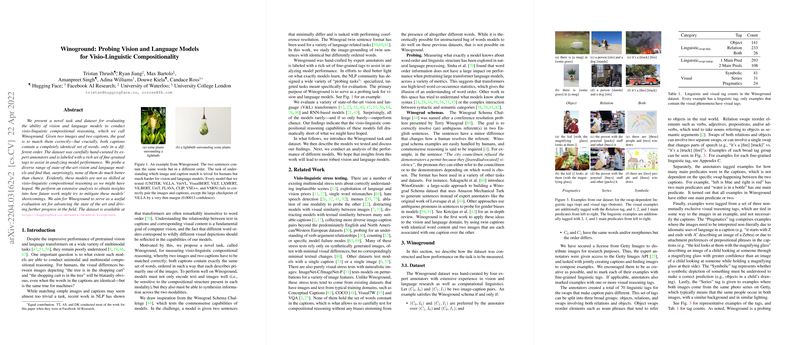Summary of "Winoground: Probing Vision and LLMs for Visio-Linguistic Compositionality"
The paper "Winoground: Probing Vision and LLMs for Visio-Linguistic Compositionality" addresses a significant limitation in contemporary vision and language (V{content}L) models: their ability to perform visio-linguistic compositional reasoning. The authors propose the Winoground task and dataset as a new benchmark to evaluate whether current state-of-the-art V{content}L models can understand the nuanced relationship between visual content and linguistic structure, especially when word order changes lead to vastly different meanings.
Task and Dataset Overview
The Winoground task involves resolving the correct image and caption pair from two provided images and two captions, where both captions use identical words in a different sequence. This setup mirrors the linguistic complexity found in Winograd schemas but extends it to the multimodal context by including images. The construction of the dataset was meticulous, with expert annotators ensuring that visual and textual elements offered a genuine test of compositional understanding.
Key Findings
Despite the impressive performance of V{content}L transformers across many other benchmarks, their capabilities at visio-linguistic compositional reasoning appear limited. The paper highlights an experimental evaluation of various models—ranging from transformers like CLIP, UNITER, and ViLT, to RNN-based architectures like VSE++—revealing that no model performs significantly better than chance, especially when evaluated with the group score metric, which demands correct pairwise identification across all combinations. The results underscore the gap between current model competencies and human-level reasoning, as the models failed to adapt to the minimal variations in task setups that significantly affect meaning.
Implications for AI Research
The results presented in the paper suggest that while these models may be competent in dealing with routine image-caption pairings, they lack an understanding of linguistic nuances. This inadequacy points to a need for further investigation into several areas:
- Attention Mechanisms and Architectural Innovations: The reliance on either single-stream or dual-stream architectures with various forms of attention did not suffice in handling compositional tasks effectively. Future research might explore hybrid designs or novel attention mechanisms that facilitate better cross-modal reasoning.
- Dataset Size and Diversity: There might be a correlation between data size and model performance, as indicated by the larger datasets used by CLIP and FLAVA models. However, the findings imply that sheer scale alone does not resolve the challenges. Developing diverse and challenging datasets that promote compositional learning could be essential.
- Pretraining Objectives: Current pretraining objectives might not emphasize compositional reasoning sufficiently. An objective tailored toward recognizing subtle semantic shifts related to word order and structure might enhance the models' understanding.
- Model Evaluation: The analysis exposes potential weaknesses in current evaluation strategies. Metrics that only assess models on an image or text-only basis miss the complexities involved in real-world task settings that integrate both modalities substantively.
Future Directions
The Winoground dataset offers a new domain for advancing V{content}L models. Future work could build on these insights by developing tasks that challenge models' understanding of narrative coherence, metaphorical language, and compositional generality across modalities. There's also scope in exploring more advanced models that leverage auxiliary multimodal information, potentially integrating neurological insights from human cognitive processing to inform model designs.
The findings serve as a call to action for the AI research community to reassess model assumptions and rigorously test real-world applicability, especially in scenarios where fine-grained understanding is crucial. The dataset not only acts as a robust benchmark but also as a guiding tool towards achieving more sophisticated machine comprehension of visio-linguistic content. Overall, the Winoground task lays the groundwork for critical advancements in computational linguistics and computer vision synergy.
